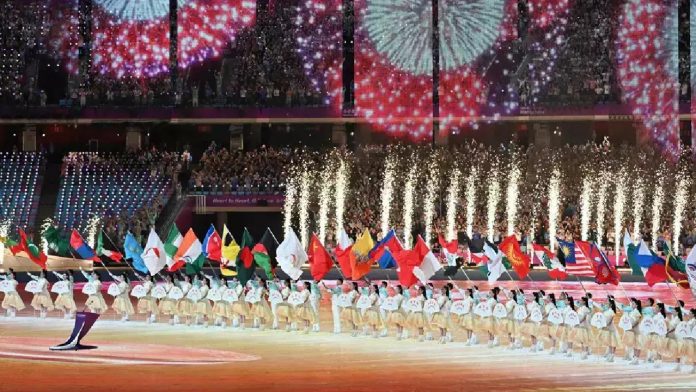The Hangzhou Asian Games kicked off on Saturday with a one-of-a-kind opening ceremony highlighted by a dazzling futuristic light show.
The Hangzhou Asian Games, which combine aspects of artificial intelligence and environmentally friendly technology, kicked off on Saturday with a one-of-a-kind opening ceremony highlighted by a dazzling futuristic light show. The stunning show, held amid a diplomatic spat over the exclusion of three Indian athletes from Arunachal Pradesh, was a mash-up of technology, Chinese cultural past, and the spirit of the continent’s unity.
In keeping with the major topic of ‘Tides Surging in Asia,’ the ceremony focused on the new era’s intertwining of China, Asia, and the world, as well as the Asian people’s togetherness, love, and friendship.
The rising tide of the Qiantang River, which flows through Hangzhou, was the underlying theme of the over two-hour-long magnificent evening.
The ceremony intended to showcase a notably Chinese and uniquely Asian flare, highlighting the country’s cultural heritage and romantic images through the mixing of its thousands of years old civilisation with current technology, through magnificent visuals.
It depicted China’s modernization efforts in a presentation that blended Eastern aesthetics with a global perspective.
The unprecedented lighting of the cauldron — the Games’ Flame — demonstrated China’s technological might.
To light the cauldron, torchbearers from the virtual and physical worlds used digital technologies.
Chinese President Xi Jinping proclaimed the Games open, as over 12,000 competitors from 45 countries prepare to compete for top honours until October 8.
The Olympic Council of Asia (OCA) acting president Randhir Singh, International Olympic Committee (IOC) head Thomas Bach, heads of many countries, executives of National Olympic Committees, and a slew of other dignitaries were in attendance.
Due to an increase in Covid cases in China last year, the Games are being staged late.
The opening ceremony used digital fireworks instead of actual ones, in keeping with the notion of ‘Green Asian Games’ or carbon-neutral Games. Nonetheless, it created a terrific atmosphere.
The nearly-full 80,000-capacity ‘Big Lotus’ stadium was magnificently decked out for the event, and athletes from participating countries, including India, were greeted with thunderous cheers.
After the Chinese government rejected visas to three wushu players from Arunachal Pradesh, India cancelled the visit of its sports minister, Anurag Thakur. PT Usha, President of the Indian Olympic Association, was not there because she is currently in Paraguay as part of a Parliamentary delegation, but other authorities were.
The roughly 100 Indian athletes and officials were greeted with loud chants as they marched into the stadium, led by flag-bearers Harmanpreet Singh and Lovlina Borgohain. The Indian contingent marched out in eighth place for the athletes’ parade.
Only Ramkumar Ramanathan from the tennis team marched in the parade because the other players had tournaments on Sunday.
Male athletes wore bandhgala jackets and khaki kurtas, while female athletes wore high-necked blouses and khaki-textured sarees created from recycled materials.
India has 655 competitors competing in the Games.
To begin, the theme ‘Water in Autumn Glow’ depicted water as the heart and spirit of Hangzhou, where water can be found in many forms, including West Lake, Qiantang Tidal Bores, the thousand-year-old Beijing-Hangzhou Grand Canal, and the Archaeological Ruin of Liangzhu City’s water conservation system.
The opening ceremony blended the flavour of Hangzhou, Zhejiang province visuals and components unique to the country in an attempt to use culture as a vehicle for mixing the strength of technology and the beauty of art inspired by traditional Chinese culture.
The ceremony also highlighted the attractiveness, appeal, and distinctive nature of Eastern aesthetics, as well as the tremendous impact culture has, the strength of science, and the all-encompassing reach of art, using breakthrough modern technologies.
Following an hour-long ceremonial portion of the ceremony, a 30-minute cultural programme delighted the audience. The Cauldron was then lit, and the official music was played.
China has hailed its return from the pandemic by staging the continent’s greatest multi-sporting event, the largest in the country’s history.
The Olympics, without a question, are the apex multi-sporting event in the globe, yet more athletes compete in the Asian Games, with over 12,000 competing in Hangzhou.
About 11,000 athletes competed in the Tokyo Olympics two years ago, and about 10,500 will compete in the Paris Games next year.
The 2018 Asian Games saw somewhat more than 11,000 athletes compete, which will be surpassed.
In addition to Hangzhou, the 19th edition of the continental showpiece will be hosted in five other cities: Huzhou, Ningbo, Shaoxing, Jinhua, and Wenzhou.
Asia’s 45 nations and territories will fight for 481 gold medals across 40 sports and 61 disciplines, including Esports, which is making its Games debut. Before Saturday’s opening ceremony, competitions in football, volleyball, cricket, rowing, sailing, and modern pentathlon began.














